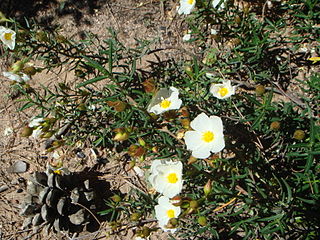
The peony or paeony is any flowering plant in the genus Paeonia, the only genus in the family Paeoniaceae. Peonies are native to Asia, Europe, and Western North America. Scientists differ on the number of species that can be distinguished, ranging from 25 to 40, although the current consensus describes 33 known species. The relationships between the species need to be further clarified.

Gentiana clusii, commonly known as flower of the sweet-lady or Clusius' gentian, is a large-flowered, short-stemmed gentian, native to Europe. It is named after Carolus Clusius, one of the earliest botanists to study alpine flora.

Doronicum is a genus of flowering plants in the sunflower family, known as leopard's bane. They are all herbaceous perennials native to Europe, southwest Asia and Siberia. They produce yellow, daisy-like flowerheads in spring and summer.

Doronicum orientale, the Oriental leopard's bane, is a European plant species in the family Asteraceae.
Leopard's bane or leopard's-bane may refer to:

Doronicum grandiflorum is a European species of Doronicum, a member of the family Asteraceae.

Asteroideae is a subfamily of the plant family Asteraceae. It contains about 70% of the species of the family. It consists of several tribes, including Astereae, Calenduleae, Eupatorieae, Gnaphalieae, Heliantheae, Senecioneae and Tageteae. Asteroideae contains plants found all over the world, many of which are shrubby. There are about 1,135 genera and 17,200 species within this subfamily; the largest genera by number of species are Helichrysum (500–600) and Artemisia (550).

The term bane, in botany, is an archaic element in the common names of plants known to be toxic or poisonous.

Doronicum corsicum is a species of the genus Doronicum and the family Asteraceae. some authors have regarded the species as belonging to either Arnica or Aronicum. It is a rare plant that has been found only on the Island of Corsica in the Mediterranean.

Paeonia broteri is a perennial, herbaceous species of peony. It is an endemic species of the Iberian Peninsula. It bears rose-pink highly fragrant flowers about 12 cm wide and glossy green leaves. It reaches up to 40 centimetres (16 in) in height.

Paeonia clusii is a relatively low (25–50 cm) species of herbaceous peony with scented, white or pink flowers of up to 12 cm in diameter. In the wild, the species can only be found on the islands of Crete and Karpathos, and Rhodes. It has pinkish-purple stem up to 30 cm long and glaucous dissected leaves. P. clusii blooms in mid-spring.
Agonopterix senecionis is a moth of the family Depressariidae. It is found from Germany, the Baltic region and Russia to the Iberian Peninsula, Italy and Romania.

Cistus clusii is a shrubby species of flowering plant in the family Cistaceae, with white flowers, native to south west and south central Europe and north Africa. It has been wrongly called Cistus libanotis by many authors.

Cistus libanotis is a shrubby species of flowering plant in the family Cistaceae, with white flowers. It has been confused with Cistus clusii, which it resembles, resulting in some uncertainty in its distribution. It is endemic to the Iberian Peninsula.

Cistus munbyi is a shrubby species of flowering plant in the family Cistaceae, with white flowers. Related to and resembling Cistus clusii, it is native to Morocco and Algeria in western north Africa.

Doronicum plantagineum, the plantain-leaved leopard's-bane or plantain false leopardbane, is a European plant species in the sunflower family. It is native to southeastern Europe from Greece and Italy to Ukraine and the Czech Republic. There are reports of the species being naturalized in the State of Oregon in the northwestern United States.

Doronicum pardalianches, known as leopard's-bane, is a species of flowering plant in the family Asteraceae. Like other members of the genus Doronicum, it is a rhizomatous herbaceous perennial. It has upright stems growing to 80 cm (31 in), with heart-shaped basal leaves and yellow flowers, generally 3–4.5 cm (1.2–1.8 in) across. It is native to western Europe and was introduced to the British Isles, where it was first recorded in Northumberland in 1633.
Aristolochia clusii is a species of plants in the family Aristolochiaceae.

Doronicum austriacum, the Austrian leopard's bane, is a species of flowering plant in the family Asteraceae. It is native to Europe and Turkey, and prefers to grow in beech and spruce forests. A clumping perennial reaching 120 cm (47 in), it is available from commercial suppliers, with the Royal Horticultural Society considering it to be a good plant to attract pollinators.














